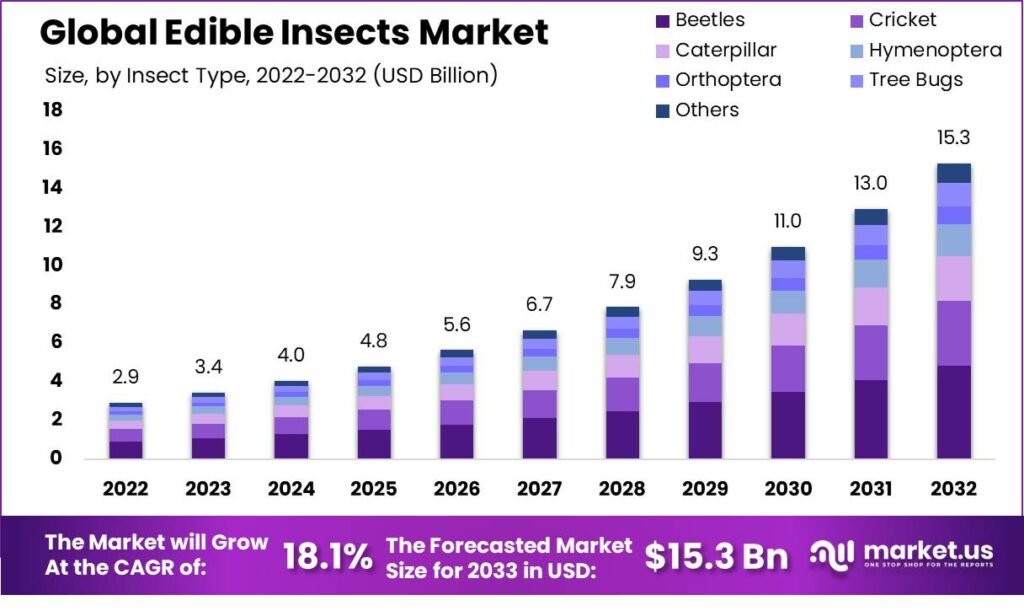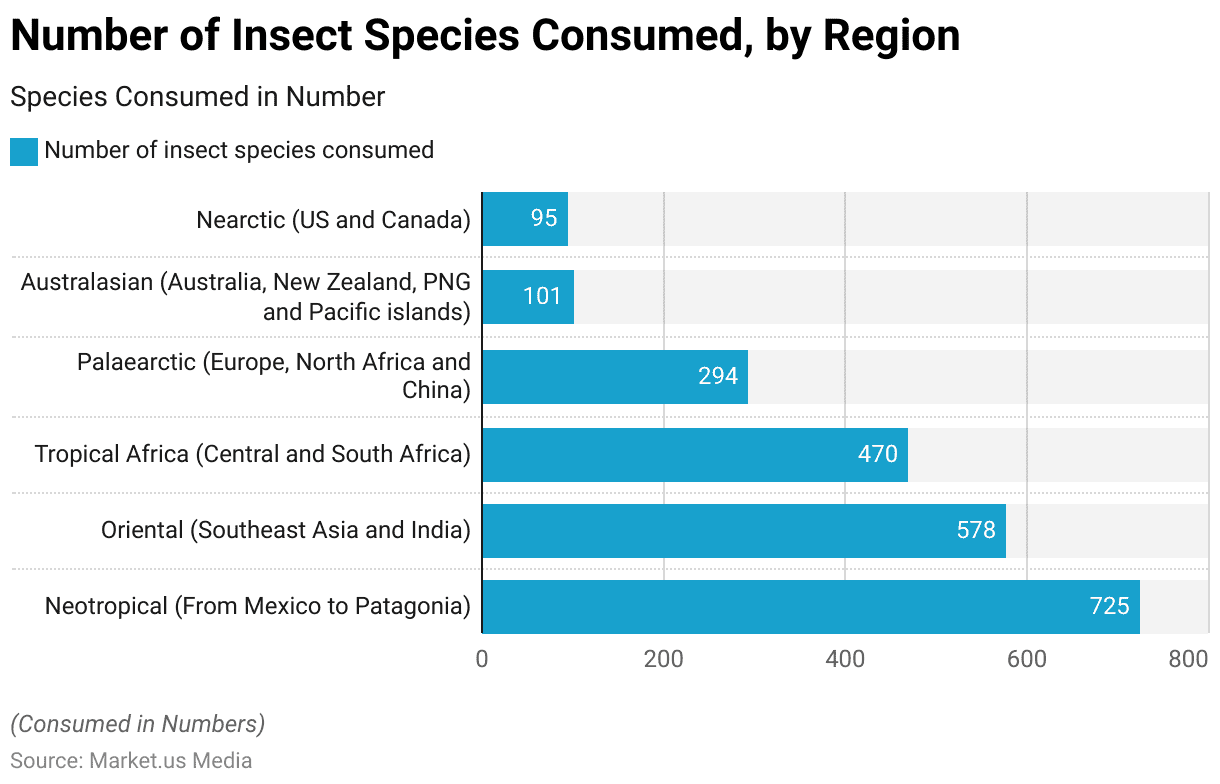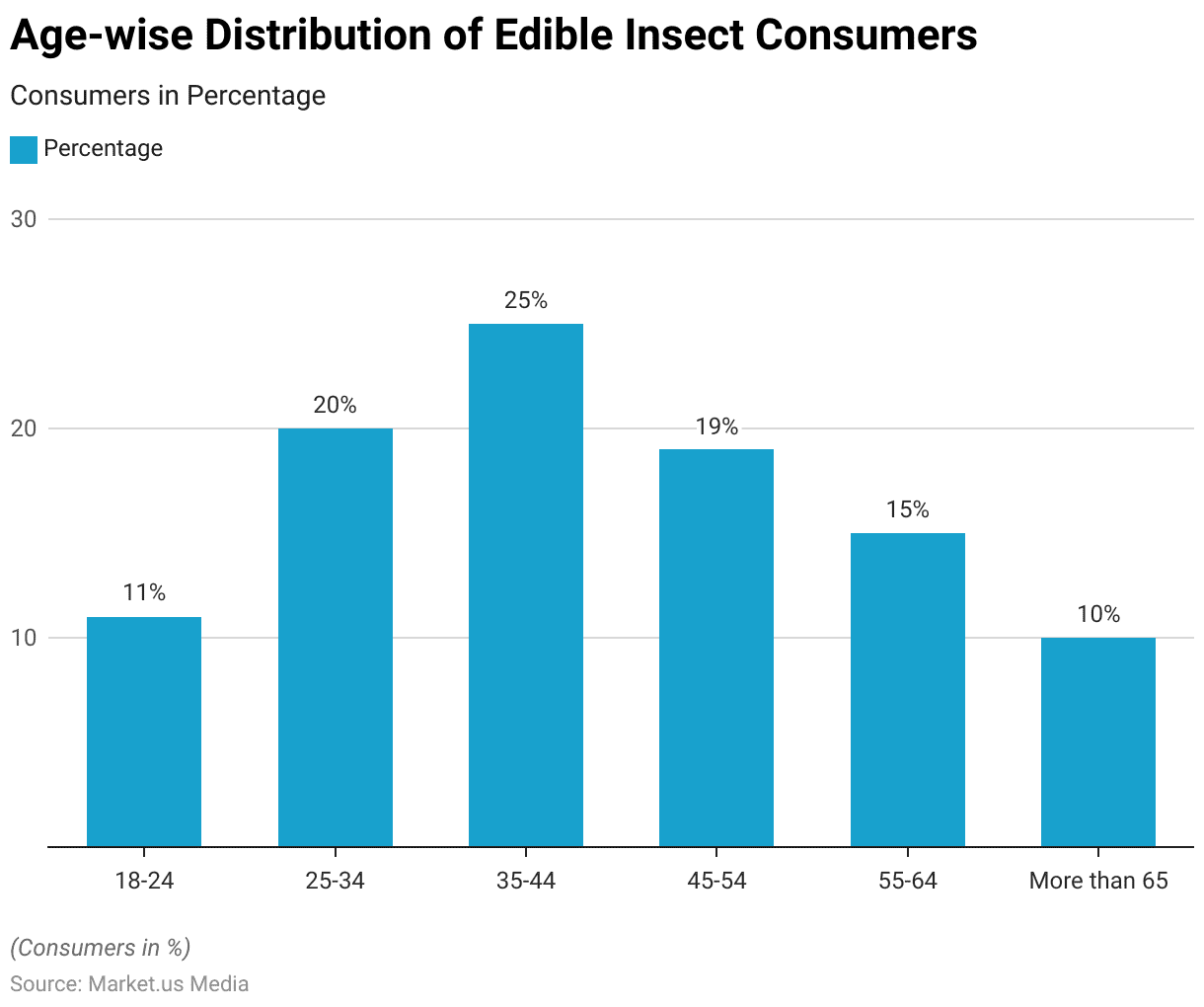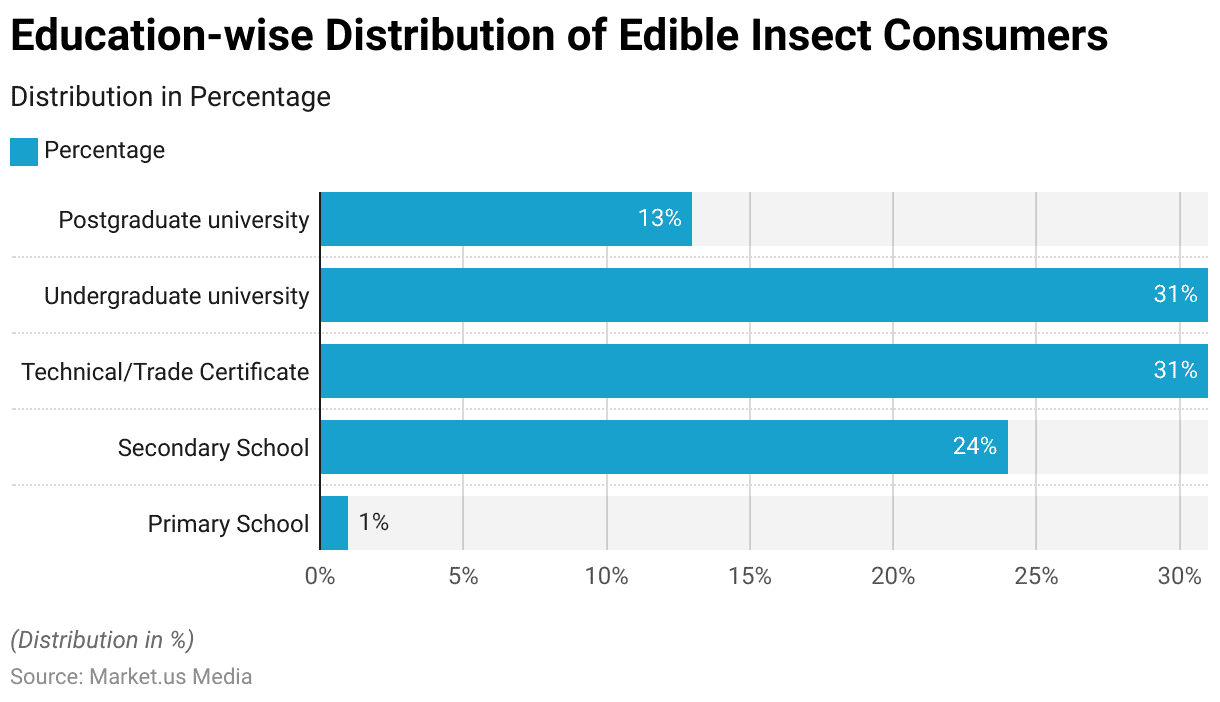Table of Contents
- Introduction
- Editor’s Choice
- Global Edible Insects Market Overview
- Major Groups of Edible Insects Statistics
- Number of Insect Species Consumed Around the World
- Demographics of Edible Insects Consumers Statistics
- Protein Content of Edible Insects Statistics
- Consumers Perspective Regarding Edible Insects
- Consumer Concerns Regarding Edible Insects Statistics
- Future Perspectives
- Recent Developments
- Conclusion
- FAQs
Introduction
Edible Insects Statistics: Edible insects are gaining favor as a sustainable and nourishing food choice, emerging as a notable trend.
Abundant in protein, vitamins, and minerals, they provide an environmentally friendly substitute for conventional livestock farming, requiring less land, water, and feed.
With a history of consumption spanning various cultures over centuries, insects are now entering mainstream diets, driven by growing concerns regarding health and environmental issues.
Despite being at an early stage, the edible insect market displays growth potential. With an array of products like protein bars and snacks hitting the market.
As consumers increasingly prioritize health and sustainability, edible insects stand to influence the future landscape of food production and consumption significantly.

Editor’s Choice
- In 2023, the global edible insects market revenue stood at USD 3.4 billion.
- In the Asia-Pacific region, the market experienced a significant decrease from USD 476.9 million in 2018 to USD 173.9 million in 2023.
- Beetles (Coleoptera) dominate the consumption landscape at 31%, followed by caterpillars (Lepidoptera) at 18%.
- The Neotropical region boasts the highest diversity from Mexico to Patagonia, with 725 insect species consumed.
- The 25-34 age group demonstrates a higher participation rate, with 20% engaging in insect consumption.
- The demographics of edible insect consumers reveal a slight gender discrepancy. With males constituting the majority at 55% and females comprising 45% of the consumer base.
- In the United States, approximately 72.5% of surveyed individuals expressed willingness to consume at least one insect-based food product.

Global Edible Insects Market Overview
Global Edible Insects Market Size Statistics
- The global edible insects market has exhibited a robust growth trajectory at a CAGR of 18.1%, with revenues steadily increasing.
- In 2022, the market revenue stood at USD 2.9 billion, followed by a notable uptick to USD 3.4 billion in 2023.
- Building on this momentum, the market is projected to continue its upward trajectory. Reaching USD 4.0 billion in 2024 and further climbing to USD 4.8 billion in 2025.
- The growth trend is expected to persist, with revenues forecasted to reach USD 5.6 billion in 2026 and USD 6.7 billion in 2027.
- As the acceptance and adoption of edible insects as a sustainable insect protein source continue to expand globally. The market is anticipated to grow substantially, with revenues reaching USD 7.9 billion in 2028, USD 9.3 billion in 2029, and USD 11.0 billion in 2030.
- The market is poised for continued expansion, with revenues projected to surge to USD 13.0 billion in 2031 and USD 15.3 billion in 2032.
- This upward trajectory underscores the growing recognition of edible insects as a viable and sustainable food source. Reflecting evolving consumer preferences and increasing emphasis on environmental sustainability in the food industry.
(Source: Market.us)

Regional Analysis of the Global Edible Insects Market Statistics
- The market value of edible insects worldwide varied across regions between 2018 and 2023.
- In the Asia-Pacific region, the market experienced a significant decrease from USD 476.9 million in 2018 to USD 173.9 million in 2023.
- Similarly, Latin America declined from USD 250.6 million in 2018 to USD 92.2 million in 2023.
- Europe also reduced from USD 261.5 million in 2018 to USD 82.1 million in 2023.
- North America experienced a notable decrease from USD 153.9 million in 2018 to USD 44.1 million in 2023.
- Meanwhile, the Middle East and Africa region declined from USD 38.7 million in 2018 to USD 14.2 million in 2023.
- These trends influence regional markets, including shifting consumer preferences, regulatory changes, and evolving market dynamics within the edible insects industry.
(Source: Statista)

Major Groups of Edible Insects Statistics
- Edible insects are categorized into major groups, contributing significantly to overall consumption.
- Beetles (Coleoptera) dominate the consumption landscape at 31%, followed by caterpillars (Lepidoptera) at 18%.
- Bees, wasps, and ants (Hymenoptera) collectively account for 14% of consumption, while grasshoppers, locusts, and crickets (Orthoptera) contribute 13%.
- Cicadas, leafhoppers, planthoppers, scale insects, and true bugs (Hemiptera) comprise 10% of the consumption share.
- Termites (Isoptera) and dragonflies (Odonata) each hold a 3% portion, whereas flies (Diptera) represent 2% of consumption.
- The remaining 5% is attributed to other insect varieties.
- This breakdown underscores the diverse array of edible insect species consumed globally. It reflects different populations and regions’ cultural and culinary preferences.
(Source: Department of Entomology of Wageningen University & Research, the Netherlands)

Percentage of Species Consumed Per Insect Order
- The percentage of species consumed per insect order provides insight into the distribution of insect consumption across various taxonomic groups.
- Coleoptera, comprising beetles, accounts for the most significant portion. With 29.6% of species consumed, reflecting their widespread consumption in diverse culinary traditions.
- Hymenoptera, encompassing bees, wasps, and ants, follows closely behind at 22.2%. Indicating their significant role as a food source in many cultures.
- Orthoptera, which includes grasshoppers, locusts, and crickets, contribute 16.9% to the overall consumption, while Lepidoptera, representing caterpillars, make up 16%.
- Hemiptera, consisting of cicadas, leafhoppers, planthoppers, scale insects, and true bugs. Account for 11.4% of species consumed, demonstrating their lesser but notable culinary presence.
- Finally, Isoptera, or termites, contribute 3.9% to the total consumption share.
- This distribution highlights the diverse utilization of insect orders as a sustainable and nutritious food source across different cultural and geographic contexts.
(Source: Commonwealth Scientific and Industrial Research Organisation 2021)

Number of Insect Species Consumed Around the World
- Insect consumption varies across different regions worldwide, with distinct numbers of species consumed in each area.
- The Neotropical region boasts the highest diversity from Mexico to Patagonia, with 725 insect species consumed.
- In the Oriental region, encompassing Southeast Asia and India. 578 species are consumed, reflecting the rich culinary traditions of these areas.
- Tropical Africa, covering Central and South Africa, follows closely with 470 species consumed, highlighting the significance of insects in local diets.
- In the Palaearctic region, including Europe, North Africa, and China. 294 insect species are consumed, albeit to a lesser extent than other regions.
- The Australasian region, comprises Australia, New Zealand, Papua New Guinea, and the Pacific islands. Features 101 species consumed, while the Nearctic region, encompassing the United States and Canada, consumes 95 insect species.
- These numbers underscore insects’ cultural and ecological importance as a food source across diverse regions globally. It reflects both culinary traditions and environmental contexts.
(Source: Commonwealth Scientific and Industrial Research Organisation 2021)

Demographics of Edible Insects Consumers Statistics
By Age
- The demographics of edible insect consumers reveal a varied distribution across different age groups.
- Among consumers aged 18-24, comprising the youngest segment, 11% partake in edible insects.
- The 25-34 age group demonstrates a higher participation rate, with 20% engaging in insect consumption.
- Consumers aged 35-44 represent the most significant demographic. With 25% actively consuming edible insects, indicating a substantial portion of the market.
- In the 45-54 age bracket, 19% of consumers participate in insect consumption, followed by 15% among those aged 55-64.
- Among individuals aged over 65, 10% engage in edible insect consumption.
- These findings suggest a diverse age distribution among consumers of edible insects, with particularly notable engagement observed among individuals aged 35-44, highlighting the relevance of age demographics in understanding consumer behavior within the edible insect market.
(Source: Research gate)

By Gender
- The demographics of edible insect consumers reveal a slight gender discrepancy, with males constituting the majority at 55% and females comprising 45% of the consumer base.
- This distribution indicates a slightly higher prevalence of edible insect consumption among males than females.
- Understanding this gender breakdown is pivotal for market analysis and targeted marketing endeavors, as it provides insights into consumer preferences and behaviors within the edible insect market.
- The predominance of males in insect consumption may stem from various factors such as cultural norms, dietary inclinations, or individual preferences.
- As the market for edible insects continues to expand, recognizing and addressing gender-specific consumption patterns can facilitate the development of tailored products and marketing strategies to effectively cater to the diverse needs and preferences of both male and female consumers.
(Source: Research gate)

By Education Level
- The demographics of edible insect consumers, categorized by education level, depict varying levels of engagement across different educational backgrounds.
- Among consumers with a primary school education, participation in edible insect consumption is minimal, accounting for only 1%.
- However, there is a notable increase in consumption among those with secondary school education, with 24% actively engaging in insect consumption.
- The trend continues to escalate among individuals holding technical/trade certificates and undergraduate university degrees, comprising 31% of the consumer base.
- Interestingly, postgraduate university-educated consumers exhibit a slightly lower participation rate at 13%.
- This breakdown underscores the influence of education on consumer behavior within the edible insect market, suggesting that higher levels of education may correlate with increased acceptance or awareness of insect-based foods.
- Understanding these educational dynamics is crucial for market analysis and developing targeted strategies to effectively reach and engage consumers across diverse educational backgrounds.
(Source: Research gate)

Protein Content of Edible Insects Statistics
- Insect species exhibit varying protein contents, reflecting their nutritional composition and potential as a protein source.
- Blattodea, commonly known as cockroaches, boasts the highest protein content at 68.33%.
- Lepidoptera, encompassing moths and butterflies, follow closely behind with a protein content of 65.25%.
- Orthoptera, including grasshoppers and crickets, demonstrate a substantial protein content of 59.17%, making them a significant protein source.
- Among other insect orders, Hymenoptera, such as bees and ants, exhibit a protein content of 51.43%, while Diptera, which includes flies, showcases a protein content of 48.88%.
- Hemiptera, comprising cicadas and true bugs, demonstrate a similar protein content at 48.83%. Coleoptera, encompassing beetles, present a protein content of 41.75%.
- These variations underscore the potential of edible insects as a valuable protein source, with certain species offering exceptionally high protein content that can contribute to dietary diversity and sustainability initiatives.
(Source: MDPI)

Consumers Perspective Regarding Edible Insects
- In the United States, approximately 72.5% of surveyed individuals expressed willingness to consume at least one insect-based food product.
- In contrast, around 67% of participants in Canada reported having already tried foods containing insects.
- In Denmark, consumers perceive insects as a sustainable food option and a viable meat substitute. Conversely, in Belgium, individuals aged 45 and above demonstrated a greater openness to accepting insect-based foods than other age demographics.
- Contrary to this trend, younger consumers generally exhibited higher receptivity to novel foods like insects; however, studies have shown that young Australians are less willing to embrace such foods.
- Moreover, in Germany, food neophobia negatively impacted the desire of children and adolescents to consume insect burgers.
- In a survey conducted as part of the Universitat Oberta de Catalunya (UOC) study on insect consumption, a majority (58%) of respondents believed in the potential for insects to emerge as an alternative and sustainable protein source. Consequently, they envision insects becoming a feasible addition to our diets.
(Source: MDPI, Universitat Oberta de Catalunya (UOC)
Consumer Concerns Regarding Edible Insects Statistics
- Approximately 25% of surveyed adults in the United Kingdom expressed willingness to sample insects, with 30% citing environmental concerns as their primary motivation.
- This percentage was slightly lower than the 34% who indicated they would consume lab-grown meat, with 40% attributing their decision to sustainability and environmental considerations.
- Exactly half of the surveyed individuals believed that edible insects were safe for consumption, compared to 77% who perceived plant-based proteins as safe and only 30% who felt the same about lab-grown meat.
- However, a significant portion (67%) expressed unwillingness to try edible insects, while 13% stated they could be convinced if assured of safety and 11% if the insects appeared appetizing.
- This survey coincides with the Food Standards Agency’s (FSA) reaffirmed commitment to supporting food innovation, mainly when it offers potential benefits for dietary health, environmental sustainability, and the UK economy.
- Nonetheless, the FSA emphasizes that consumer interests and food safety remain paramount in food-related initiatives.
(Source: All About Feed)
Future Perspectives
- Despite initial reluctance, attitudes toward insect consumption can improve under specific circumstances.
- Nearly half of the respondents (approximately 50%) expressed that access to information regarding the sustainability of insect-based food could positively influence their willingness to consume it, while 48% disagreed.
- There is evident optimism regarding the future acceptance of insect consumption, with 58% of participants expressing positivity towards its potential adoption, while 38% remained hesitant.
- Additionally, respondents emphasized the importance of preparing insects for consumption, with 70% indicating that disguising insects’ natural appearance would enhance their appeal.
- Conversely, 10% believed showcasing insects naturally could make them more appealing.
- Among the preferred formats for insect consumption, flour emerged as the most popular choice (23%), followed by biscuits (6%) and bars (5.8%).
(Source: Universitat Oberta de Catalunya (UOC)
Recent Developments
Product Launches and Innovations:
- Insect powder is gaining traction, driving growth through its integration into various food products like energy bars, protein shakes, and baked goods.
- New fully integrated pet food lines utilizing sustainably sourced insects were launched by FeedWerkz in February 2022, addressing the demand among environmentally conscious pet owners.
Strategic Investments and Funding:
- Chapul Farms secured $2.5 million in January 2022 to expand operations focusing on using insects for waste management and climate impact mitigation.
- Entomo, a Canadian startup, secured C$3.7 million in February 2021 to advance the use of cricket protein.
- Series B funding round for an insect-based protein company in February 2024, raising $50 million to scale production capacity and develop new product lines.
- Seed funding for a vertical farming startup focusing on edible insect cultivation in April 2024, securing $12 million for research and development initiatives.
Acquisitions and Partnerships:
- Bühler Holding AG partnered with Alfa Laval AB in March 2019 to deliver advanced solutions for the insect protein sector.
- Aspire Food Group and Lotte Confectionery signed an MOU in September 2022 to collaborate on protein alternatives and edible insects.
Expansion Initiatives:
- Yensect completed the construction of Ynfarm in January 2023, recognized as the largest insect farm globally, aiming to accelerate the supply chain of its products.
- InnovaFeed expanded its operations in Decatur, Illinois, with a $250 million investment in September 2022, enhancing the production of black soldier flies.
Investment Landscape:
- Venture capital investments in edible insect startups totaled $800 million by 2023, focusing on companies developing innovative insect-based food products and sustainable farming technologies.
- Strategic partnerships and acquisitions between food manufacturers, retail chains, and agricultural companies accounted for 70% of total investment activity in the edible insects market in 2023, reflecting industry efforts to capitalize on the growing consumer interest in alternative protein sources and sustainable food options.
Conclusion
Edible Insects Statistics – The edible insect market shows promise as a sustainable protein source. Despite initial reservations, consumer attitudes are gradually changing, with more people open to incorporating insect-based foods into their diets.
However, challenges such as consumer perception and regulatory frameworks remain. Efforts to educate consumers about the safety and nutritional value of edible insects can help drive acceptance.
The market is poised for growth with advancements in farming and food processing technologies and growing awareness of environmental sustainability.
Collaboration among industry stakeholders and support from regulatory bodies will be crucial for realizing the market’s full potential in addressing food security and ecological concerns.
FAQs
Yes, edible insects are safe for human consumption. They are commonly consumed in many cultures worldwide and are rich in protein and other nutrients.
Edible insects are rich in protein, vitamins, and minerals. They are also low in fat and can be a sustainable and environmentally friendly source of nutrition.
The taste of edible insects can vary depending on the species and their preparation. Some people describe them as nutty, earthy, or similar to other protein sources like chicken or fish.
Yes, farming insects requires less land, water, and feed than traditional livestock farming, making them a more sustainable food option with lower environmental impact.
Common edible insect species include crickets, mealworms, grasshoppers, and beetles. These insects can be consumed whole or processed into food products like protein bars, snacks, and flour.
Discuss your needs with our analyst
Please share your requirements with more details so our analyst can check if they can solve your problem(s)



